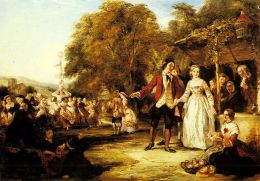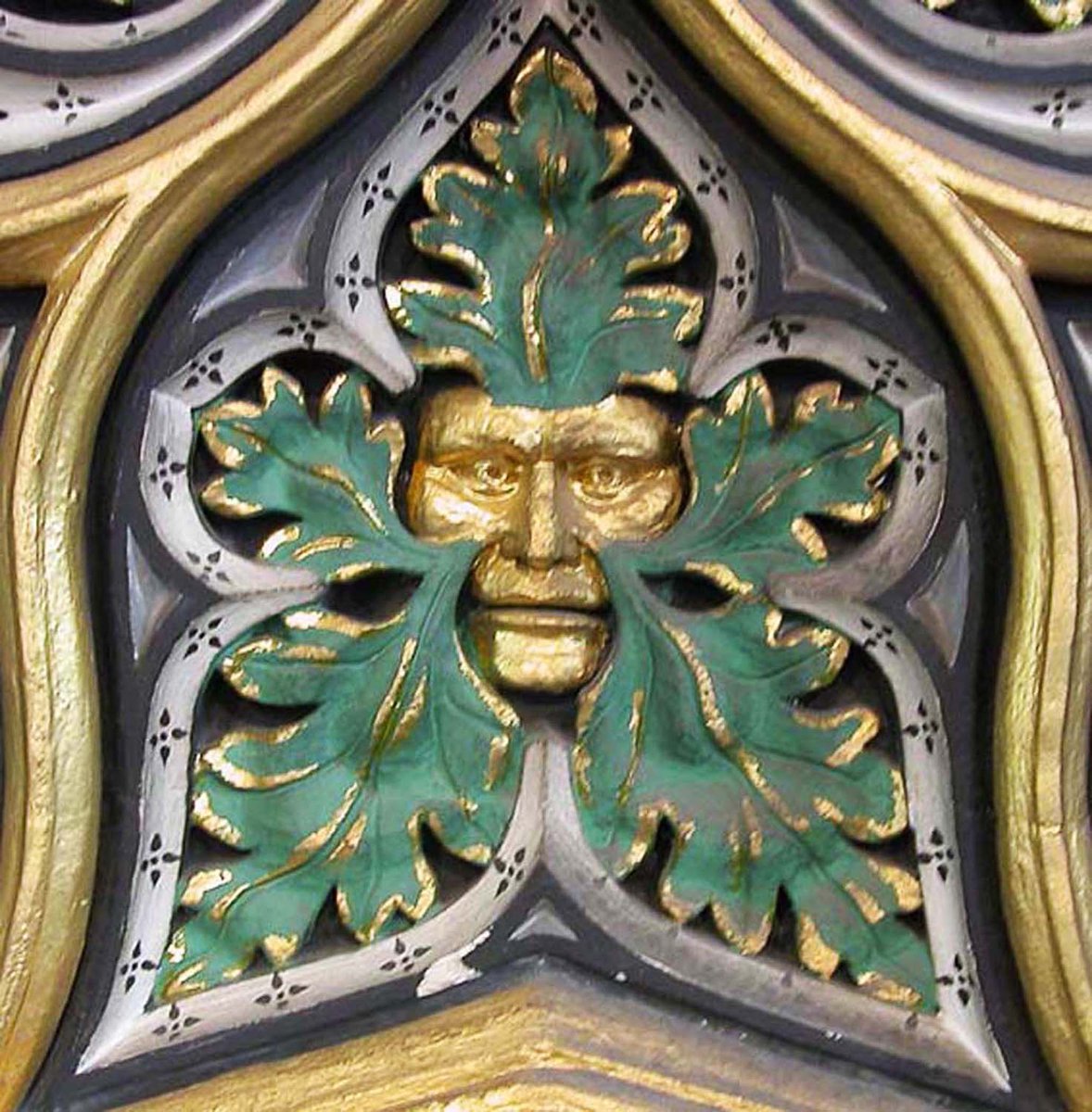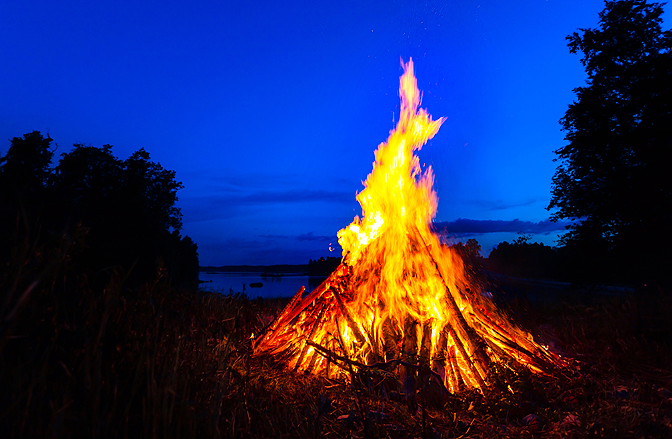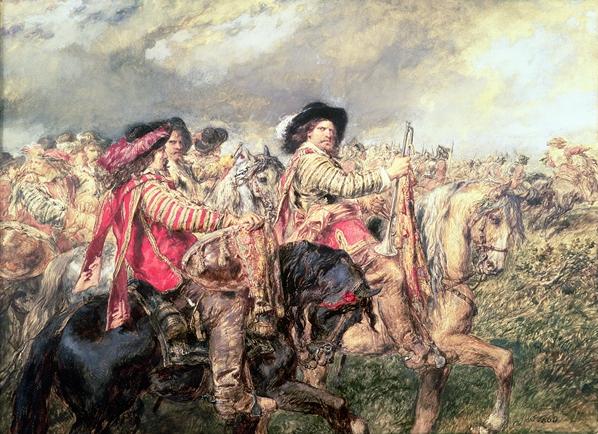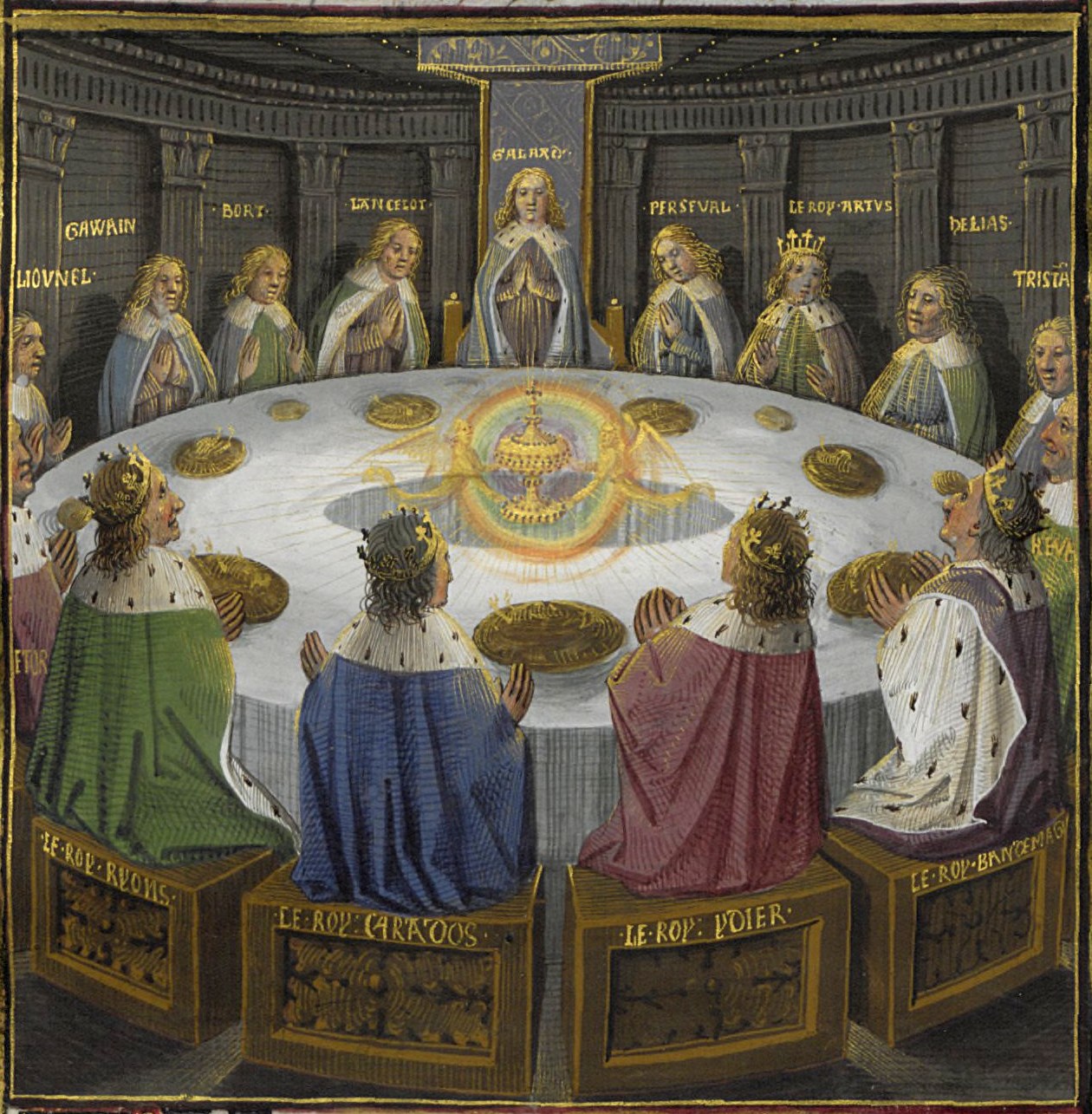Whitsuntide: Sacred Fire, Divine Gifts, & the Quest for the Holy Grail
Posted By William de Vere On In North American New Right | Comments Disabled6,740 words
Throughout Europe and the United States, the chill mornings and blossoming trees of spring are giving way to summer’s warmth and abundance. As the midway point between spring and summer, the month of May has historically been a season of great importance to the peoples of Europe, a joyful time of sowing, revelry, feasting, and courtship.
One of the greatest feasts in the Christian calendar falls in this season, when spring shades into summer: Pentecost, known by the more poetic name of “Whitsunday” or “Whitsun” in old England, takes place fifty days after Easter (whence it’s Greek name, pentēkostē) and thus can occur any time between May 10 and June 13. This year, it fell on May 23, with celebrations taking place throughout the week following, known as Whitsuntide. In Christian tradition, this feast commemorates the descent of the Holy Ghost upon Christ’s apostles. In addition to its religious significance, Whitsunday [2] was once one of the major holidays of the year, a day of communal merriment marking the end of the Eastertide. People would celebrate by holding parties in their parish known as “Whitsun ales [3],” reveling in Morris Dances [4], indulging in sports such as archery, horse racing, “leaping, vaulting, or any other such harmless recreation” (as recounted in James I’s “Declaration of Sports” [5]), and decorating their churches and homes with rushes and newly budded beech branches. It was also a day of literal feasting, with the English Whitsunday dinner often featuring a roasted goose stuffed with apples, onions, and sage. In France, it was customary to picnic with cold meat pies and Galantine, while in Germany celebrants would feast on great dishes of sauerkraut and bratwurst.
Many Whitsunday traditions in the British Isles were likely derived from the revels of May Day, itself a survival of the ancient Gaelic festival of Beltane [6]. Like Whitsunday, May Day was celebrated with giant bonfires throughout the countryside, which were held to have protective powers. Celebrants would leap over the flames for good luck, while cattle were likewise believed to be protected by the smoke and flames as they were driven out to summer pastures.
In both the ancient Gaelic festival as well as the later Whitsun celebration, ale held a place of high honor. While certain Protestant sects developed an obsessive loathing of alcohol, it was regarded more positively by early Christians (Christ himself, of course, famously turned water into wine at Cana and offered His blood in the form of wine in the mystery of the Eucharist). There is even a medieval blessing for beer, which reads: “Bless, O Lord, this creature, ale, which by Thy power has been produced from kernels of grain. May it be a healthful beverage to mankind, and grant that through the invoking of Thy holy name all who drink thereof may find it a help in body and protection in soul.” The “Whitsun-ale” was one of a few large yearly celebrations in the church courtyard, where the ale brewed by the churchwardens and the profits went to the poor and the upkeep of the church. As one observer wrote of these festivities in 1870 [7],
After the feasters had eaten and drunk to contentment, if not to excess, they took part in sport on the turf of the churchyard, or on the sward of the village green. The athletes of the parish distinguished themselves in wrestling, boxing, quoit throwing; the children cheered the mummers and the morris dancers; and round a maypole decorated with ribbons, the lads and lasses plied their nimble feet to the music of the fifes, bagpipes, drums and fiddles.
As this nineteenth-century observer mentions, one of the most well-known May traditions is, of course, the Maypole dances. While most commonly associated with May Day itself, these were actually popular throughout the May season, and in some countries were not erected until Pentecost. The youth of the village would arise before dawn to “go a-Maying [8],” venturing into the woods to gather greenery and cut down a sturdy tree. This tree would be decorated with colorful ribbons and danced around by the young people, to the accompaniment of feasting, drinking, and song — not infrequently followed by many childbirths nine months later. Perhaps ironically, on Beltane and Whitsunday it was customary for single women and girls to wear new white dresses. This is one suggested meaning for the English name of “Whitsunday,” as the day was associated in England with white dresses, white baptismal vestments, and white doves (the Holy Spirit is commonly symbolized by a dove, inspired by the New Testament imagery of Christ’s baptism in the Jordan [9], when “the heavens were opened unto him, and he saw the Spirit of God descending like a dove, and lighting upon him”). Beltane was also a day when offerings of milk and honey would be left out for the fairies, and it was believed that washing one’s face and feet with the morning dew would bring beauty and good luck (as the dew of May was reputed to have restorative and curative powers [10]).
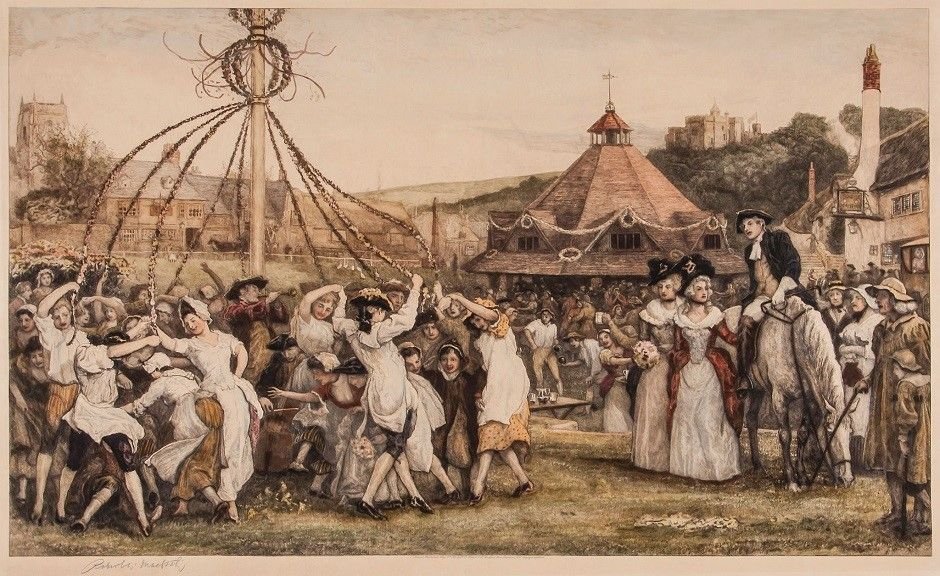 [11]
[11]Robert Walker Macbeth, “An Old English Custom, dancing round the Maypole on the Village Green,” Illustration for the Graphic, May 2, 1896.
Additionally, at both Beltane and Whitsun, livestock and homes would be decorated with flowers and flowering branches, particularly those of a red and orange hue reminiscent of fire. Throughout history, May has been associated with the celebration of springtime and new life. Though regarded as demonic by the early church, a rehabilitated version of the “Green Man” — himself derived from the ancient god of the woodlands known as Sylvanus by the Romans and Cernunnos by the Celts — came to play an important role in the Whitsun revels. In medieval times [12], “the Green Man becomes a generally more friendly character. . . a symbol of the goodness of creation and the fruitfulness of the land which spring and summer festivals celebrated.” A villager would be decked with greenery and a mask of bark, then escorted into town to preside over the Whitsun games and festivities. Another ancient custom that survives to this day is the game of “cheese rolling,” which may derive from an ancient Beltane ritual of rolling burning disks (representing the sun) down hillsides. Its later iteration was more of a raucous game, in which the wheel of cheese was sent rolling down a steep hill and whoever caught it was able to keep it for himself.
In other countries of Europe, the May season was celebrated with similar revels, being associated variously with the Roman festival of Flora (goddess of fruits and flowers), as well as the Norse goddess Freya (goddess of fruit trees, gardens, flowers, and romantic love). Though these May festivities have gone out of fashion in the last century, observed primarily by churchgoers, neopagans, and communists [14], they play an important role in our ancestral seasonal observances and thus in the European collective psyche. Especially for the peoples of the cold northern climes, the month marking the beginning of the all-too-brief summer was a particular time of joy and merriment. In this essay, I wish to focus on the most salient themes of these May festivals: their shared celebration of sacred fire and divine gifts, as well as their significance to the Grail legend, the defining myth of Christendom.
Sacred Fires
A key feature of these May celebrations is their association with fire. As mentioned above, Beltane is an ancient Irish fire festival, on which the community would light a giant bonfire for its protective qualities. In Germany and other northern European countries, the eve of May Day was celebrated as Walpurgisnacht [15], when huge bonfires were lit throughout the countryside to ward off the witches who are believed to congregate on that night.
Whitsunday itself is a Christian fire festival of sorts. Most will be familiar with the Pentecost story from Sunday school: forty days following His resurrection, Christ has ascended to heaven, leaving His disciples adrift in Jerusalem awaiting the coming of the “other helper” promised by their lord. Ten days later, this promise is fulfilled [17]:
And suddenly there came a sound from heaven as of a rushing mighty wind, and it filled all the house where they were sitting. And there appeared unto them cloven tongues as of fire, and it sat upon each of them. And they were all filled with the Holy Ghost, and began to speak with other tongues, as the Spirit gave them utterance.
In medieval France, this was commemorated during the Pentecost mass by the blowing of trumpets, signifying the “rushing mighty wind” of the spirit descending upon the apostles. Likewise, into the present day, churches and liturgical vestments are decorated with red to represent the fire of the Holy Ghost, with parishioners encouraged to wear red clothes in commemoration of the event. In medieval central Europe, some churches even dropped pieces of burning straw from the ceiling to represent the tongues of fire (a custom that was discontinued after several churches burnt to the ground).
The fires of these May festivals have clear symbolic meanings. For one, there is the association of fire with the sun, whose strength is now approaching its apex (May was traditionally regarded as the beginning of the summer season). Fire possesses a purgative aspect, clearing away the dead undergrowth of winter in order to make way for new life. This hints at the dual nature of fire in the human psyche: it is a force of destruction, while at the same time a cultivator and protector of life. Fire wards away darkness and cold and hunger, and its protective function is further illustrated in the old Beltane tradition of lighting fires to ward off witches and to protect cattle as they are driven into summer pastures.
This depiction of fire as a source of new life has a deeper metaphysical significance. In many ancient cultures, fire was revered as the first principle of the cosmos, the agent of creation, and a symbol of divine light. It was regarded as such by Heraclitus, and the Stoics would later envision the “breath of life” (pneuma [19]), which combines the qualities of air and fire, as the active, generative principle of both the individual soul and the cosmos, the life-giving spirit immanent in the universe. Plotinus, father of Neoplatonism, would later describe [20] fire as a symbol of the “invasion of incorporeal light [to] overwhelm the darkness inherent in matter. [. . .] Always struggling aloft, this subtlest of elements is at the last limits of the bodily [. . .] It sparkles and glows like an Idea.” These classical notions later informed the Christian understanding of the Holy Spirit as the third person of the Godhead and creative agent of the material world, immortalized in the Nicene Creed’s description of the Holy Spirit as “the Lord, the Giver of Life.”
These ancient esoteric truths are expressed scientifically in the theory of the Big Bang, according to which the known universe resulted from the explosion of a primordial singularity — a mass of almost infinite density and heat, eventually giving birth to the stars, galaxies, and planets of our universe. All that we know to exist, all the elements that make up life on earth and the human body, came into being as a result of this cosmic event. If one accepts that all matter is endowed in some sense with spirit — as traditional Christianity, Neoplatonism, Hinduism, Taoism, pantheism, and most indigenous religions do — it is difficult not to give this a spiritual cast. Pentecost and the bonfires of Beltane are a celebration of this sacred primeval fire.
In the words of Jonathan Gardner [22], this season is
a time when we open ourselves to the Source of All, and give thanks for new life and new hope, for vitality, fecundity and empowerment. Whatever is the animating force of the universe — present in us and every living creature, and in water, wind, earth/rock and fire — this Living force was made manifest on that first Pentecost Sunday and continues to pervade all, today.
Like the pneuma of the Stoics and the divine flame of Neoplatonism, the Holy Spirit of Christianity is worshiped as the sacred fire that breathed soul into mankind. The tongues of flame descending upon the apostles on Pentecost are a visible manifestation of this divine creative fire, through which the spirit of God reentered the fallen world and both man and Creation are to be renewed.
Divine Gifts
In addition to its role as the generative principle of the cosmos, the Holy Spirit is celebrated on Whitsunday as a bestower of divine gifts. When the Paraclete descended upon the apostles, it blessed them with various qualities: “Charity, joy, peace, patience, benignity (kindness), goodness, longanimity (forbearance), mildness (gentleness), faith, modesty, continency (self-control), and chastity.” In addition to these gifts of personal sanctification, the Holy Spirit is also believed to be the source of supernatural graces, or charismata [23], which are used to further God’s will, the mission of the Church militant, and the good of mankind. These include
the word of wisdom, the word of knowledge, increased faith, the gifts of healing, the gift of miracles, prophecy, the discernment of spirits, diverse kinds of tongues, [and] interpretation of tongues. To these are added the gifts of apostles, prophets, teachers, helps (connected to service of the poor and sick), and governments (or leadership ability) which are connected with certain offices in the Church.
Our particular talents and graces, whether they be skill in leadership, martial pursuits, art, child-rearing, domesticity, craftsmanship, mechanical skills, agriculture — all are gifts of the Holy Spirit through which we are to serve our people and our God. In addition, by endowing mankind with grace and supernatural gifts, “the Lord, the Giver of Life” has abolished the gulf between ourselves and the transcendent realm.
This is a day for celebrating those unique gifts that God has granted us, which includes not only our particular graces and virtues but also our families, cultures, peoples, and homelands — all things on this good Earth that are worth fighting for. The lesson of the New Testament parable of the talents [24] is that we must not squander the gifts of God, whether they be our abilities, our graces, or the circumstances of our birth. Even gifts of a more worldly nature are blessings to be celebrated, not temptations to be destroyed.
One of God’s greatest gifts to mankind is the splendor of the natural world. Though beautiful in all seasons, this time of year it takes on a particularly striking aspect, with flowers in full bloom and the trees displaying their fresh green leaves. As referenced above, the “Green Man [12]” of pagan Europe was incorporated into the Whitsunday festivities, a representation of the created world, the bounteous earth and all its fruits. Indeed, the Morris Dances of Whitsunday often incorporated woodland characters such as Robin Hood and his merry band. Given his association with the greenwood as well as his generosity, Robin Hood was particularly favored during the May revels and was often given the role of “May King,” presiding over the festivities and games (particularly archery, which was particularly popular this feast day). His typical Lincoln green attire is also appropriate for Whitsunday, as it is the color of life and nature, symbolized by the greenery with which homes and churches were traditionally decorated at this time of year.
 [25]
[25]Daniel Maclise, Robin Hood and His Merry Men Entertaining Richard the Lionheart in Sherwood Forest, (1806–1870), Nottingham City Museums & Galleries [26]
In the contemporary world, these aspects of the May season all serve as reminders of our responsibilities to the rest of creation, as stewards, cultivators, and observers of the wonders of the natural world, as well as the endless gifts nature and God have bestowed upon us. The primordial meaning of prayer, according to Christopher Bamford [27], lies in its expression of
trust, praise, gratitude, and lamentation: unconditional trust, without which nothing may be received; praise to the Creator for the glory, magnificence, and powers of his Work, the Universe; gratitude for the continuous gift of the Universe, its Life and Light — that is, for All that has been given and is still and ever being given; and, finally and continually, lamentation for humanity’s dereliction of its appointed task as divine mediator, for its selfishness and arrogance in setting itself up as self-constituted and autonomous, for its oblivion that everything is given and its preferring itself to God and God’s gifts.
The May revels are especially associated with the gifts of renewal and fertility. Crops have been planted, the beasts of the field and forest are giving birth, and “the young man’s fancy lightly turns to thoughts of love [28].” Beltane, as well as the May Day festival derived from it, celebrates this season of fecundity, and the Maypole itself is believed to have originally functioned as a phallic symbol [29]. The May revels are thus a celebration of fertility and love, and in Catholic Europe, a spike in births frequently occurred nine months after. As 17th century English poet Robert Herrick describes the spirit of the season [30],
THE May-pole is up,
Now give me the cup,
I’ll drink to the garlands around it;
But first unto those
Whose hands did compose
The glory of flowers that crown’d it.
A health to my girls,
Whose husbands may earls
Or lords be, granting my wishes,
And when that ye wed
To the bridal bed,
Then multiply all, like to fishes.
The orgiastic nature of the May revels is apparently related to a prehistoric notion of sympathetic magic, the belief that these erotic activities would ensure abundant crops in the months to follow. Though this celebration of sexuality might seem to be at odds with Christian ideas of purity and chastity, the traditional view considers sexuality — properly expressed, in the context of a sacred bond and serving a unitive/procreative rather than purely sensual function — to be a gift. Indeed, this time of year is a most fitting one for marriage. Love of creation, appreciation for the gifts of God, and seasons of mirth and festivity are not opposed to a true religiosity, provided these do not become idols in themselves.
Of course, not everyone feels this way. The Puritans of 17th-century England and New England notoriously wished to rid the world of holidays, especially the “papist” feasts of Christmas, Easter, and Whitsunday. As one disgruntled Puritan commented [10] concerning the festive mood of Whitsunday, “They feast, banquet and dance all that day and (peradventure) all the night too. [. . .] Another sort of fantastical fools bring to these hell-hounds [. . .] some bread, some good ale, some new cheese, some old, some custards, and fine cakes.” Puritans refused to tolerate any religious practices that could not be justified by scripture, and were especially offended by the amalgamation of Christian and pre-Christian customs embraced by folk Catholicism. They wholeheartedly opposed merrymaking, even on Sundays — the only day workmen had freedom to engage in games or gaiety — with the Puritan elect insisting that the Lord’s day ought to be spent in prayer and good works. This Puritan loathing of old world revelry is captured well in Nathaniel Hawthorne’s “The May-Pole of Merry Mount.” [32] English Puritan Henry Burton [10] described holy days and festivals as “rubbish of Romish relics, [because] every day to a true Christian is a day of sobriety, and all his life a Lent, while all along his life is seasoned and sanctified with a conscionable keeping of the Lord’s day.” It is notable that the higher May conception rates in Catholic countries, and in the Anglican/Catholic Southern colonies, had no parallel in Puritan New England.
 [33]
[33]Anonymous 19th-century engraving of Captain Miles Standish with his garrison observing the maypole festivities at Merrymount
Opposite the Puritans stood both recusant Catholics and high church Anglicans, as well as the Stuart monarchs themselves. In 1617 James I issued his “Declaration of Sports,” which was reissued by Charles I in 1633 and was written against efforts by “Puritanes & precise people” to ban sports and recreation on Sundays and holy days. Arguing that such measures would deprive workers and the poor of “honest mirth” after their week of drudgery, the declaration reiterated the lawfulness of “May-Games, Whitsun-ales, and Morrisdances, and the setting up of May-poles” as well as archery, dancing, bowling, “leaping, vaulting, [and] any other such harmless recreation.”
Among the staunchest defenders of the king and Merry Old England itself were the cavaliers [34]. So named for their role (literal or symbolic) as defenders of the legitimate monarchs against the Puritan usurpers, these warrior poets were notable for their celebration of love, festivals, nature, and the rituals of the high church and monarchy. They defended the Stuart kings and the traditions of old England on the battlefield against the austere, iron tyranny of Cromwell, until their loss at the Battle of Worcester in 1651.
Despite their temporal defeat, their ideals survived through the writing of representatives such as Robert Herrick, Thomas Carew, and Sir John Suckling. Their poetry [36] was marked by a celebration of “beauty, love, nature, sensuality, drinking, good fellowship, honor, and social life.” Replete with allegorical and classical references, their works evinced a profound nostalgia for the holidays, rituals, and country life of old Catholic and Tudor England. As Herrick described his poetry [37],
I sing of brooks, of blossoms, birds, and bowers,
Of April, May, of June, and July flowers;
I sing of may-poles, hock-carts, wassails, wakes,
Of bridegrooms, brides, and of their bridal cakes. . .
This nostalgia was particularly acute regarding the disappearance of the May revels, which were an especially sacred time for those of a cavalier temperament due to the season’s association with youthful exuberance, love, sensuality, and natural beauty. As one William Fennor wrote [10], lamenting the decline of May customs as early as 1619:
Happy the age and harmlesse were the dayes,
(For then true love and amity was found,)
When every village did a May-pole raise,
And Whitson-ales, and May-games did abound: [. . .]
Then Lords of Castles, Mannor, Townes and Towers,
Rejoyc’d when they beheld the Farmers flourish,
And would come downe, unto the Sommer-Bower
To see the country gallants daunce the Morris. . .
But since the Sommer-poles were overthrowne,
And all good sports and merriments decayed,
How times and men are chang’d. . .
The Puritans in England and the United States rejected these customs as pagan accretions upon the pure Christian faith and condemned all holidays as exercises in vanity and sinful excess. And undeniably, the Puritans were correct in some of their criticisms of the Stuart court. Some of these cavaliers might have fallen into a degree of dissolution that is contrary to true religion and service to God and country. However, while this gay and merry band of nobles, warriors, and troubadours might have been given to excess on the side of sensuality, their appraisal of life was ultimately the truer and indeed the more Christian one. As one writer [38] in the American South observed in 1860, writing of the conflict between Puritan and cavalier and its parallels to the American conflict between the Yankee and Southerner:
The cavaliers had many human failings; they were, indeed, of the earth, earthy; they fought, they drank, they swore, and they loved, as better men will neither fight, nor drink, nor swear, nor love — but that made to pretense to unusual sanctity, and they were a gallant, high-spirited, chivalrous, and generous race, of the pure Anglo-Saxon blood [. . .] Knowing that earth could not be made a paradise, they did not, therefore, seek to turn the fair footstool of God into a gloomy hell. Failings they had, but dishonor, sordid meanness, and mammon worship, they knew not; and they served their king and their church, with a loyal devotion that history has seldom paralleled.
The old Puritan, like the cynic and the ironist, scoffed at all that is good in the material world — all true innocence, beauty, happiness, and childlike wonder — and crushed the souls of their youth into submission. This ethos persists, in an altered but equally tyrannical and joyless form, in today’s radical politics. But this puritanical gloom and denial is an insult to the Creator. A love of God and desire to serve Him need not be at odds with a joy in God’s creation and His gifts, those of nature and art, beauty and love, wisdom and virtue. These qualities are nowhere more on display than at this joyful time of year. May is truly the season of the cavalier.
The Quest for the Holy Grail
This time of year also hearkens back to another famous warrior band, one that occupies a central place in the mythos of Christendom: King Arthur and his knights. According to the medieval literature, Whitsunday was a day of great feasting at Arthur’s court, as it was the day on which King Arthur was crowned. Every year thereafter it was his custom “that at the high feast of Pentecost especially, afore al other high feasts in the yeare, he would not goe that day to meat until he had heard or seene some great adventure or mervaile.” It was, appropriately, on this day that Sir Galahad took his place at the Siege Perilous — the vacant seat at the Round Table reserved for the knight who would attain the Holy Grail — and also the day on which Arthur’s knights had a vision of the Holy Grail that inspired them to begin their quest. A Thomas Malory describes it in Le Morte D’Arthur [39]:
Then anon they heard cracking and crying of thunder, that them thought the place should all to-drive. In the midst of this blast entered a sunbeam more clearer by seven times than ever they saw day, and all they were alighted of the grace of the Holy Ghost. Then began every knight to behold other, and either saw other, by their seeming, fairer than ever they saw afore. [. . .] Then there entered into the hall the Holy Grail covered with white samite, but there was none might see it, nor who bare it. [. . .] And when the Holy Grail had been borne through the hall, then the holy vessel departed suddenly, that they wist not where it became: then had they all breath to speak. And then the king yielded thankings to God, of His good grace that he had sent them. Certes, said the king, we ought to thank our Lord Jesu greatly for that he hath shewed us this day, at the reverence of this high feast of Pentecost.
On the most obvious level, made clear in the excerpt above, beginning the Grail quest on Whitsunday is appropriate; it is the day when Christ’s apostles were baptized in fire, and when baptisms of infants traditionally took place, representing the divine call to salvation. But there is an even deeper esoteric meaning to the Holy Grail, befitting its distant origins in the Indo-European past and its role as the ultimate myth of European consciousness.
This meaning has been depicted in its different dimensions by many thinkers, and I cannot begin to survey them all. Most relevant to my purposes is the depiction of the Grail as a primordial or “Hyperborean” mystery, one that has its roots in the deep Indo-European past and flowered in the European Middle Ages. According to Rene Guenon [41], medieval expositors of the legend held that angels fashioned the Grail from an emerald dropped from the forehead of Lucifer during his fall from heaven. It was subsequently entrusted to Adam, but was lost when he was exiled from his earthly paradise. However, Adam’s son Seth was able to return to Eden to recover the Grail, after which it was passed down by secret keepers until the coming of Christ.
What is the esoteric meaning of this account? Lucifer’s loss of his crown and its bestowal upon Adam symbolizes the passing of Lucifer’s exalted position, envy and hatred for which led him to tempt Adam away from his inheritance. The Grail, then, is the symbol of humanity’s divine origins, his primordial state of purity and integration and union with God. When Satan succeeded in corrupting man and severing his will from that of God, man “finds himself henceforth confined to the temporal sphere; he can no longer regain the unique point from which all things are contemplated under the aspect of eternity.” Through a kind of divine grace, Seth was able to recover the Grail and the wisdom of the primordial state was able to survive, dispersed, in various spiritual traditions throughout the world — Greek philosophers, Persian kings, Muslim mystics, and Celtic Druids, among others: “Thus there was henceforth at least a partial restoration, in the sense that Seth and those who after him possessed the Grail could thereby establish, somewhere on Earth, a spiritual center which was an image of the lost Paradise.”
There is a notable parallel here to the Arthurian Grail figure of the wounded Fisher King, whose wasteland kingdom can only be restored by the hero of the Holy Grail. In one respect, this legend symbolizes the loss of man’s primordial estate, the wounding of his essential nature, and the need for psychic reintegration and union with God in order to restore human nature as well as the earth itself.
What, then, does the Holy Grail mean when it enters a specifically Christian context? In medieval legend, the Grail became the cup from which Christ drank at the Last Supper, the chalice for the wine which became his blood, instituting the mystery of the Eucharist. It was also the vessel that caught the blood streaming from his pierced side on Golgotha. For the esoteric meaning of this account, we turn to Sergius Bulgakov [42]. Though man was in possession of the Grail since the earliest age, as a vessel of primordial wisdom, its meaning is not complete until it receives the blood of Christ. Though Bulgakov does not say it, we can speculate that this is because, while man could attain elevated states of being in the pre-Christian world, his wisdom was ultimately one of rites and law rather than grace and love; moreover, earth and man were still under the dominion of the dark powers. Christ, through the Eucharist and through his triumphant death and resurrection [43], liberated the world from the Enemy and restored man’s ability to achieve union with God. Christ’s blood, spilled on the ground at Golgotha, thereby re-sanctifies both man and the earth. As Bulgakov writes:
Through the stream of Christ’s precious blood and water that flowed out of his side, all creation was sanctified — heaven and earth, our earthly world, and all the stellar worlds. The image of the Holy Grail expresses precisely the idea that the world received His holy relic in the blood and water [. . .] The whole world is the chalice of the Holy Grail.
Though Christ’s death and resurrection began the process of liberating man and nature from the prince of the world, the primordial state can only be regained by man’s free will. The Grail henceforth becomes an invisible power, hidden from the world, appearing only to those who are pure and worthy of its appearance. This is the import of the Arthurian mythos, in which the Grail is only attained by the purest and most chivalrous of knights (Galahad, Perceval, and Bors in most accounts). Otto Rahn [44] believed that the Grail was preserved by the Cathars, the “pure ones,” who maintained the primordial and authentic religious tradition of the North and Christ against the power-hungry Church of Rome. This is perhaps the mystic kernel of truth in the otherwise quite outré interpretations of Nicholas de Vere, Laurence Gardner, and the authors of Holy Blood, Holy Grail: those without the inherent capacity, the grace and the blood, to see the Grail will not find it. Those who do possess it will realize that the Grail’s power is not to be sought externally, but within.
 [45]
[45]Detail of a Miniature of Christ Crucified between the two thieves, with the Virgin Mary and John the Evangelist, and Joseph of Arimathea collecting Christ’s blood in a dish (France, Saint-Omer or Tournai), British Museum.
There is one additional aspect of the Grail we must consider, one that particularly links it to the Europe of the Middle Ages. The legend holds that the Grail was brought to the West by Joseph of Arimathea, whence it came into the possession of various secret groups. In Julius Evola’s Mystery of the Grail [46], the Grail was interpreted as the seed and symbol of the Holy Roman Empire, the sacrum imperium that would serve to unite the Western world into a bastion of primordial wisdom.
On the one hand, the kingdom of the Grail is not a physical place — it is a spiritual reality to which the elect from all over the world are called. In the chivalric literature of the thirteenth and fourteenth centuries, the path to the Grail is cleared “with weapons at hand,” with duels and long sojourns, indicating a path of spiritual realization in which the warrior element plays a vital role (108). However, the knight who achieves the Grail must not be simply physically strongest, but also possessed of a certain wisdom and mysterious spiritual quality. The kingdom of the Grail is “a land that will never be invaded, to which one belongs for reasons other than mere physical birth, in virtue of a dignity that is different from all other dignities and that links in an unbreakable chain men who may appear to be scattered in the world, in space and time, among various nations” (119). The kingdom of the Grail thus transcends petty nationalism and forms the bond between all true knights of old Europe, those who
awaited the hero of the Grail, so that the head of the Holy Roman Empire could become an image or a manifestation of the Universal Ruler; so that all the forces could receive a new power; so that the Dry Tree could blossom again; so that an absolute driving force could arise to overcome any usurpation, antagonism, laceration; so that a real solar order could be formed; so that the invisible emperor could also be the manifest one; and finally, so that the “Middle Age” (medium aeveum) could also have the meaning of an “Age of the Center.”
Though this ideal is timeless, it came closest to achievement in the Europe of the Middle Ages. The Ghibelline party, a transnational band of warlords, princes, scholars, and poets, was dedicated to supporting the sacred imperial cause against the temporal encroachments of a corrupt and militaristic party. In their most ideal meaning (perhaps only embodied by Dante, who despite his pragmatic alliance with the Florentine White Guelfs espoused thoroughly pro-imperial ideals), these Ghibellines fought for the kingdom of the Holy Grail, an empire unified by the primordial wisdom and dedicated to human transcendence. Thus, while “in its polar character this kingdom is immobile,”
For a certain period of time it seemed that the Ghibelline Middle Ages approximated this kingdom to a great degree. This epoch appeared to offer sufficient conditions for the “kingdom of the Grail” to turn from occult into manifest, affirming itself as a reality that is simultaneously inner and outer, in a unity of the spiritual authority and of the temporal power, just as it was in the beginning. In this way it can be said that the regality of the Grail constituted the apex of the medieval imperial myth and the highest profession of faith of the great Ghibelline movement. (120)
Taking all of this together, what is the meaning of the Grail, and why it is a subject of perennial fascination throughout the history of the West? It represents wholeness, integration, and the restoration of man’s primordial state, as well as the sacrum imperium that would unite Christendom beneath the banner of the universal priest-king. It is immortality, purity, and perfection; it is the gift of the Holy Spirit and the flame of the primordial tradition. It is the aspiration of every knight, the object of both the inner and the outer war. The Grail is all of these things, and for a century and a half its legend was an animating force in the European consciousness. Whitsunday is therefore a day when we are reminded of this quest, the striving for wholeness and integration within ourselves and with the divine. It is also when we are reminded of our duty to keep the flame of the sacred tradition alive and work, in whatever way our talents allow, towards the restoration of a regime dedicated to justice, order, integrity, and transcendence.
The Feast of Rededication
In addition to marking the beginning of the Grail quest, Whitsunday holds another significant role in Arthurian legend, as the day of the year when all of King Arthur’s knights were called upon to renew their oaths of chivalry. As Thomas Malory recounts [48],
The king stablished all his knights, and gave lands to them that were of lands not rich, and charged them never to do outrage nor murder, and always to flee treason; also, by no mean to be cruel, but to give mercy unto him that asketh mercy, upon pain of forfeiture of their worship and of the lordship of King Arthur for evermore; and always to do ladies, damosels, and gentlewomen succor upon pain of death. Also, that no man take no battles in a wrongful quarrel for no law, not for no world’s goods. Unto this were all the knights sworn of the Table Round, both old and young. And every year were they sworn at the high feast of Pentecost.
Whitsunday also commemorates the birth of the Church, the body of Christ on Earth. Though there is much corruption, venality, perversity, and evil in the history of the papal curia, the Church nevertheless transcends its particular historical manifestations and remains the last remaining bastion of transcendent values in the West. It has historically provided Western man with a pathway to transcendence through ritual and works, and has been a guiding force in what is greatest in Christendom — its Gothic art and cathedrals and walled cities, its sacred music, its military monastic orders, its chivalric ethos and tradition of kingship, its Spanish and English empires, and its synthesis of Roman, Greek, and Germanic thought and custom beneath the banner of the cross. Whitsunday commemorates the birth of the Church militant, when Christ’s departure from the physical plane forced his apostles to accept the responsibility of doing God’s work in the world. Whitsunday is also when the festive period of Eastertide officially ends, resuming the period of laboring for the kingdom of God (thus, despite its decidedly anti-Christian origins, the more recent association of May Day with the labor movement may not be wholly inappropriate).
Whatever your station in life, let this be a day of celebration and rededication. Let us acknowledge and give thanks for the sacred fire that animates the universe and the gifts we have received, and think on how we might best use them to serve our people and our gods. Conceive of yourself as a remnant of the Knights Templar [50] or the Dúnedain Rangers [51], dedicated to doing God’s will on Earth, defending the innocent, and preserving spiritual truths against the servants of the enemy. But above all, let us do so with a sense of joy in the goodness of Creation. This is a season of renewed vigor and youth, and no matter how old we are (or feel), the fires of Whitsunday can enliven our bodies and spirits for the glorious struggle ahead.
* * *
Counter-Currents has extended special privileges to those who donate $120 or more per year.
- First, donor comments will appear immediately instead of waiting in a moderation queue. (People who abuse this privilege will lose it.)
- Second, donors will have immediate access to all Counter-Currents posts. Non-donors will find that one post a day, five posts a week will be behind a “paywall” and will be available to the general public after 30 days.
To get full access to all content behind the paywall, sign up here:
Selected Resources
Professing Faith: History and Customs of Pentecost [52]
The Homely Hours: Simple Pentecost Traditions for the Home [53]
Full Homely Divinity: Pentecost or Whitsunday [12]
“The Forgotten Art of Gayety: The Puritans and Merry Old England” [10]
Feast Day Cookbook [54]
Whitsun Week [55]
Proto-Indo-European Religion, May Day Revels 1 [56], 2 [57], and 3 [58]
